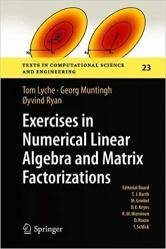 Название: Exercises in Numerical Linear Algebra and Matrix Factorizations
Название: Exercises in Numerical Linear Algebra and Matrix FactorizationsАвтор: Tom Lyche, Georg Muntingh
Издательство: Springer
Серия: Texts in Computational Science and Engineering
Год: 2020
Страниц: 273
Язык: английский
Формат: pdf (true)
Размер: 10.1 MB
To put the world of linear algebra to advanced use, it is not enough to merely understand the theory; there is a significant gap between the theory of linear algebra and its myriad expressions in nearly every computational domain. To bridge this gap, it is essential to process the theory by solving many exercises, thus obtaining a firmer grasp of its diverse applications. Similarly, from a theoretical perspective, diving into the literature on advanced linear algebra often reveals more and more topics that are deferred to exercises instead of being treated in the main text. As exercises grow more complex and numerous, it becomes increasingly important to provide supporting material and guidelines on how to solve them, supporting students’ learning process.
This book provides precisely this type of supporting material for the textbook “Numerical Linear Algebra and Matrix Factorizations,” published as Vol. 22 of Springer’s Texts in Computational Science and Engineering series. Instead of omitting details or merely providing rough outlines, this book offers detailed proofs, and connects the solutions to the corresponding results in the textbook. Both the textbook and solutions are self-contained. This book and the textbook are of similar length, demonstrating that solutions should not be considered a minor aspect when learning at advanced levels.
Many solutions contain code listings. The corresponding files can be found online together with the code from the book at site. The listings also include the corresponding file names. All code listed in the solutions is MATLAB code, but the code directory also contains a Python module numlinalg.py, which contains the main functions from the first five chapters translated to Python. The code is very similar, but the Python versions naturally take advantage of several things in the Python language. As an example, parameters in Python are passed by reference, not by value.
The reader may notice that some exercises, in particular older exam exercises, are more difficult than others. A partial explanation to this may be that all aids were permitted in older exams. The reader may also notice that some of those older exams use pseudocode, and are formulated in a way that encourages students to write loops, where one nowadays would prefer vectorized code. Time may again be a partial explanation: The oldest exercises originated way back in the infancy of languages like MATLAB, when modern programming standards were still not established.
Скачать Exercises in Numerical Linear Algebra and Matrix Factorizations